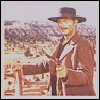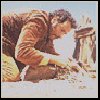 The Good -
The Man With No Name
The Good -
The Man With No Name The Good -
The Man With No Name
The Good -
The Man With No NameClint Eastwood plays the lead role of the "man with no name", the trademark poncho and cigarillo make him an instantly recognisable character. It is interesting to note from the way that Blondie dresses that this is the first film of the trilogy, although the sharp eye will pick out the clearly visible dates on the graves in San Miguel, placing A Fistful of Dollars at least as late as 1873, while The Good, The Bad, And The Ugly is during the Civil War, some years earlier. When he sees a dying soldier on the floor, Blondie bends over and picks up the poncho that has become a trademark of the character, and is clearly recognisible in the two other films.
The character redefined the way in which heroes were viewed in film, as the birth of the original anti-hero was established. A cold killer, who plays by his own rules, the only difference between him and Angel Eyes being an almost miniscule amount of humility. This is perhaps most evident in the first and the third films, certain actions suggest this such as saving Marisol and her family, and his disillusionment at the human cost of war
Originally however Eastwood did not figure in Leone's plans for the character, and was only asked when Henry Fonda, James Coburn and Charles Bronson turned down the part.
 The Bad - Angel
Eyes
The Bad - Angel
EyesA part also originally planned for another actor the role of Angel Eyes was initally planned for (the blue-eyed) Henry Fonda. However after Fonda`s refusal, Leone decided to offer the role to Lee Van Cleef, Who played Colonel Mortimer in For A Few Dollars More.
The character portrayed by Van Cleef in the film is a ruthless killer without a hint of morality, except for an ethical standard that insists that he carries out every job for which he is employed. To be truthful in appearance alone Van Cleef could not look any more like an outlaw, the snake eyes and the thin face exude terror.
 The Ugly -
Tuco
The Ugly -
TucoAt times Tuco seems almost to be a clown and a character which accentuates the images of Blondie and Angel Eyes. This judgement would be unfair however, there are many scenes where Tuco shows that if not intellectually, in other areas he is a match for the other two characters. "The Ugly" is almost too heavy a description for the character. His reasons for becoming a bandit are made clear when he meets his brother in the monastery where Blondie is taken to recover.